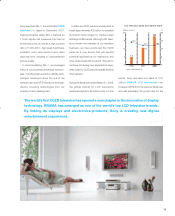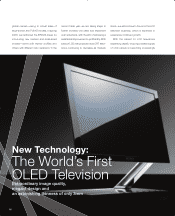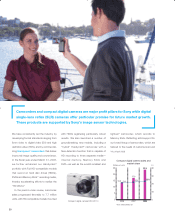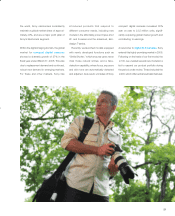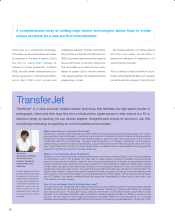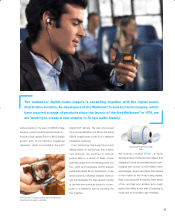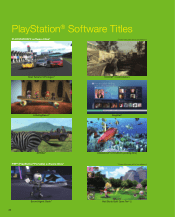Sony 2008 Annual Report Download - page 26
Download and view the complete annual report
Please find page 26 of the 2008 Sony annual report below. You can navigate through the pages in the report by either clicking on the pages listed below, or by using the keyword search tool below to find specific information within the annual report.
24
which give us a competitive advantage.
Conversely, we have implemented a number
of measures in the area of system LSIs in
line with our “Asset Light” strategy for
reducing in-house production. In March
2008, we sold certain semiconductor pro-
duction equipment to Toshiba Corporation,
and in April 2008 a joint venture was
established between Toshiba Corporation,
Sony and Sony Computer Entertainment Inc.
(SCE) to produce semiconductors using the
above-mentioned production equipment.
This will enable us to outsource the manu-
facture of system LSIs to the joint venture,
while keeping system LSI development and
engineering in-house.
By focusing attention on image sensors
and other core areas, we will strive to
improve the effi ciency of investment in our
semiconductor business.
R&D continues to yield a wealth of revolu-
tionary technologies that allow us to develop
products which are unique to Sony. Recent
A comprehensive array of cutting-edge device technologies allows Sony to create
unique products for a new world of entertainment.
What prompted you to develop TransferJet?
Cell phones, compact digital cameras and other mobile devices are popular across all age groups, but for many
people printing their photographs or watching home videos on a television is still not as easy as they would like.
We wanted to create a wireless system that would be easy for anyone to use—even people who are not entirely
comfortable with PCs and networks. This was what prompted us to develop TransferJet. Sony’s superior
craftsmanship consistently inspires new lifestyles. Just as the development of FeliCa has given rise to the “touch
& go” style of electronic ticketing for public transportation, we believe that our new wireless technology has the
potential to signifi cantly transform the way people live.
What is so revolutionary about TransferJet?
Wireless communication generally requires authentication and other complex settings. Even I fi nd such systems
counterintuitive, and I’m an engineer. Our idea was to make wireless recognition between devices possible
simply by touching them together. It was this new concept that allowed us to develop a revolutionary interface
using low-intensity radio waves that only travel a maximum of 3cm, making it possible to transfer large volumes
of data easily and quickly. By intentionally limiting the communication distance to 3cm, we prevent crossed
signals and ensure the radio waves only reach the device with which they are intended to communicate. The
merits of this are that it reduces the need for security and data encryption circuits, as well as minimizing power
consumption, which will make it easier to promote global adoption of the system. With a maximum transmission
rate of 375Mbps, this system facilitates things like stress-free downloading of video from a camcorder to an
LCD television for easy viewing.
How do you anticipate this technology being used?
The chip used in the TransferJet technology is miniscule, so it can be easily mounted in compact digital cameras
and PCs, as well as in cell phones and other mobile devices. Mounting it together with FeliCa, for example,
would allow the user to “touch & get” music, videos and information via TransferJet while using FeliCa to settle
payment. This mechanism will also make it possible to develop business models for offering a variety of new
services. We will make the technological specifi cations available while promoting TransferJet as a universal
interface and accelerating development efforts with the aim of achieving commercialization in fi scal year 2009.
Jun Iwasaki
Deputy General Manager,
TransferJet Business
Promotion Department,
Corporate R&D, Sony
Corporation
A wireless engineer, Jun Iwasaki
has been involved in technology
development—including ultra-
wideband wireless technology—
for many years. Building on his
considerable experience and
expertise, Iwasaki leads the
team responsible for the
development of the TransferJet
close proximity wireless transfer
technology.
TransferJet™ is a close proximity wireless transfer technology that facilitates the high-speed transfer of
photographs, videos and other large fi les from a cellular phone, digital camera or video camera to a PC or
television simply by touching the two devices together. Straightforward enough for anyone to use, this
revolutionary technology is expanding the world of wireless communication.
TransferJet
08SonyE_P14_27_0802.indd 2408SonyE_P14_27_0802.indd 24 08.8.7 2:18:51 PM08.8.7 2:18:51 PM



